Deflationary Gap: 東アジア経済学会第6回世界大会丹羽報告
(平成10年8月)
Reprinted from Journal of Asian Economics, > Vol.11 ,No.2,(2000),PP.245-258
The Recent Deflationary Gap in Japan: A Quantitative Measurement
(copyright (C) 2000 Elsevier Science Inc.)
by
Haruki Niwa*
(With Permission from Elsevier Science)
Short abstract:
Undoubtedly, the deflationary gap in the economy of recent Japan is very great. However, the White Paper series of EPAJ(Economic Planning Agency of Japanese Government) in recent years depends on a questionable interpretation of the concept of the gap, so that its analyses have been very misleading.
In this paper, the author made up his mind to try to contrive an alternative way for measurement of the deflationary gap. The estimating procedure in the present study is as follows:
(1) Computation of aggregate ‘full employment and full utilization indexes’ of labor force and enterprises’ real fixed capital stock, by the use of ‘original weights’ and ‘adjusted weights’,
(2) Experimental-exogenous setting of the δ ratio, i. e.,the ratio of the ‘yearly rate of technological progress(%) ’to the ‘ yearly growth rate of real GNP(%) ’,
(3) Computation of the indexes of ‘full capacity GNP’ corresponding to each δ ratio,
(4) Measurement of the deflationary gap.
In the light of the computed results, we conclude that the deflationary gap in the recent (1997) Japan would amount to around 30-40% of the potential full-capacity GNP. The excessive breeding of deflationary gap in the Japanese economy was not a cyclical phenomenon but a long-term cumulative trend.
List of keywords:
Deflationary Gap in Japan, Simulation, Production Function, EPAJ’s White Paper,
Orthodox versus Questionable Concept of Deflationary Gap
The Recent Deflationary Gap in Japan: A Quantitative Measurement
Haruki Niwa*
1. Orthodox Concept versus “False” Concept of Deflationary Gap
Undoubtedly, the recent deflationary gap in the economy of Japan is very great. The most impressive evidence for it is that, in Japan, while the real fixed capital stock of private enterprises (EPAJ’s data, all sectors) expanded by 7.2 times in real terms from 1970 to 1997, the real GNP(or real GDP) increased by merely 2.66 times and industrial production came to a halt, as indicated by the mere 2.24 times’ increase during the same period. 1
However, if we inappropriately interpret the concept of ‘deflationary gap’ as the temporal downward deviation of real GNP(or real GDP) from its average trend line, the size of such a ‘deflationary gap’ would appear to be not very large, say, only 2%, which is EPAJ’s estimate for the 1st quarter of 1998 (severe depression days).2 Properly saying from the standpoint of common sense of economics, such a very small-size deflationary-gap of 2% would mean extremely superheated situations of boom, the actual state of things of Japan in 1998 was a worst slump.
Unfortunately, the White Paperseries of EPAJ(Economic Planning Agency of Japanese Government) in recent years depends on a questionable concept (as cited above) of the ‘deflationary gap’, so that its analyses have been very misleading.3
Since 1970 to the present time, in the Japanese economy, such an average trend line of actual real GNP(or real GDP) itself has been deviating below the potential ‘full-employment and full-utilization ceiling’ of production capacity by a large margin. There has been a long lasting tendency of ever-diverging difference between both trends of actual GNP(or GDP) and potential full-capacity GNP(GDP). It could be regarded that the divergence is the defrationary gap in a widely accepted orthodox sense.
The accurate measurement of deflationary gap by the use of the widely accepted truthful concept, i.e., the estimate of the difference between potential full-capacity GNP(GDP) and actual GNP(GDP), ought to be a basic prerequisite for any macro-economic policy making. In this regard, the recent misleading measurements by EPAJ, as criticized above, may be very harmful for the economic policy of Japan.
In the present-day Japan, unfortunately, research works for precise quantitative measurement of the daflationary gap by the use of correct concept (as cited above) are very few, except for several computations by the author.4 After due consideration on the above-mentioned state of things, I would like to estimate the size of the deflationary gap in present-day Japan in terms of widely accepted concept, in this study.
2. Unreliable Data Compilation in EPAJ’s White Paper
It should be noted here that the reliability of the official (MITI) ‘index of capacity utilization’ of fixed capital stock in the manufacturing industry is very questionable.5 The index is derived by the use of the following formula:
Index of capacity utilization
= (Index of production)/(Index of productive capacity of fixed capital) .
Both indexes in the right side, i.e., ‘production index’ and ‘productive capacity index’, are computed from only 150 sample items of old-type, traditional commodities (in case of ‘1985 base’ index). This selection is quite insufficient as a representative sample. In other words, the coverage of the capacity utilization index does not include the larger part of modern high-tech sectors. As the index is mostly derived from samples of rather old, mature and stagnant industries, it is not sensitive to the trade cycle and economic change. It appears that the MITI index always tends to underestimate the magnitude of not only fluctuations but also long-term changes in capacity utilization as a whole.
For the EPAJ’s estimate of a production function (cited in White Paperseries), the data for capital inputs in manufacturing industry rely upon the MITI index of capacity utilization criticized above, namely, the EPAJ index of enterprises’ real fixed capital stock (in terms of ‘gross’ concept subtracted with the acquisition cost of worn out and abandoned assets) has been multiplied by the MITI index. As the Economic Research Institute of EPAJ urged, the index of enterprises’ real fixed capital stock should also be regarded as an indicator of the productive capability of capital plant.6 The value of the MITI’s capacity utilization index for 1993, compared with the level in 1970, was 0.82 (1970=1.0).7 During the same period, the actual increase in manufacturing production in Japan was twofold. Therefore, it seems we ought to consider that the level of productive capacity in Japanese manufacturing industry should be increased by about 2.4 times (= 2 times ÷ 0 . 82) from 1970 to 1993. ( The year, 1993, was the final year for many important series of official real term indexes at ‘1985 prices’, so that, we must rely on some linked indexes, mostly linked with indexes at ‘1990 prices’, for the period from 1993 to the present.) However, according to the estimate by the EPAJ, the increase in real fixed capital stock in manufacturing enterprises was fivefold during the same period.8 The discrepancy between the two values ( 2.4 times vs. 5 times) is quite large, though we must consider the possibility of increases in the required capital/output ratio. The EPAJ has ignored this inconsistency.
Worse still, the EPAJ’s estimation studies of production functions make no allowance for any changes in the capacity-utilization-ratios of capital inputs in any sectors other than the manufacturing industry.9 Consequently, the EPAJ’s estimation procedure entails a strong upward bias in the trend of capital input data. If we base our estimates on the EPAJ’s procedure of data compilation, we would get the computed results shown in Table 1.
As is well known, the Japanese performance in building up high-technology sectors of industry was quite remarkable during the 1970s and 80s and the consequent rate of technological progress was actually splendid. Nevertheless, the computed rates of productivity increase of aggregate inputs ( i.e., the Solow’s residual ) shown in Table 1 are very low ( 0.22 ? 0.28% per annum), or virtually nil.
As discussed in Section 6, when we tried to adjust the imputation of the incomes of the not-incorporated small private enterprises, the aggregation weights were altered to 0.42 for capital and 0.58 for labor, while the original weights derived from the official national income accounts for 1985 were 0.456 and 0.544. However, the consequent changes in the obtained results by the use of ‘adjusted weights’ are trivial as cited in the note to Table 1. In this case, the computed average rate of technological progress is 0.43% per annum during the period of 1970-93. Though the adjusted value of technological progress is slightly higher than original computation, it is still too small, i.e., only 1/9 or 1/10 of the actual growth rate of real GNP. The very small value would also be far from the reality.
In Japan, these two decades(1970s and 80s) were also an era of remarkable structural change in the manufacturing sector from capital intensive ‘big plant industry’ to knowledge intensive ‘light-thin-short-small goods’ industry. There were no necessary conditions for large increases in the ‘required capital/output ratio’. Contrary to this, Table 1 shows a very large increase in ‘required capital/output ratio’. Needless to say, the calculations cited in Table 1 are extremely unrealistic. These computed results surely have come from the above-stated upwardly biased data for capital inputs; therefore, I make my estimates without using the official ‘index of capacity utilization’.
3. Shortcomings of Conventional Estimating Methods for Production Functions
Probably the most common procedure for estimating the parameters of a production function, , especially in the case of widely used Cobb-Douglas type function, would be from multiple regression measurements by the method of least squares. However, it seems the conventional method is subject to three serious shortcomings:
- The regression coefficients for labor and capital would be merely an indirect approximation to the relative proportions of earnings of both production factors. In addition, especially when we use time-series samples, the values of these coefficients are uncertain because of the effects of multicollinearity. Therefore, when we can find more reliable value of the relative proportions of earnings from official national income accounts, this value should have priority of usage. The recent series of EPAJ’s White Paperignores this principle of priority in its estimates of production functions.10
- In customary regression procedures, the rate of technological progress is estimated simply as a semi log linear function of chronological time. Such an over-simplified estimation tends to be very rough and untrustworthy (because effective determinants for technological progress must be, if properly speaking, multifarious). Its computed value may be very unreliable due to the ill-conditioned effects of multicollinearity.
- In so far as we use time-series data, we should expect a very high multiple inter-correlation among three regressors, i.e., capital, labor and time-trend, in the estimation of production functions. In such cases, the conventional procedure of multiple regression method inevitably encounters the problems of multicollinearity, as suggested above.11 In sum, a basic prerequisite for stochastic function is that there should be no inter-correlation among regressors. Even in the case of a seemingly good fit in which the calculated value of R2-coefficient is high and t-values for the estimated parameters are also acceptable, we cannot easily escape the consequences of multicollinearity if the basic prerequisite is not satisfied, i.e., the estimated regression coefficients must be largely distorted and unreliable. Consistency of the regression coefficients with the relative proportions of each factor’s earnings in national income accounts may be lost. In some instances, it would be responsible for outstanding distortions in the computed results of some important policy simulation analyses.
The well-known studies by Edward Denison(1974), Abram Bergson(1963), Richard Moorsteen and Raymond Powell(1966) and others to measure increases in productivity of aggregated inputs without use of the methods of multiple regression estimates of production functions provide a means to avoid the shortcomings of the parametric production function approach.12 After due consideration of the above-stated three shortcomings, I chose to give up the idea of using the method of multiple regression estimates of a production function. I have tried to contrive an alternative way for my measurement of deflationary gap.
4. Estimating Procedure in this Study
My estimating procedure is as follows:
(1) Computation of an aggregate ‘full employment & full utilization index’ of labor force and enterprises’ real fixed capital stock:
This aggregate input index in real terms at 1985 prices (as cited in Appendix Table 1 below) has been consistently computed by a weighted geometric mean formula with ‘1985 weights’ (cited in the note to Table 1) as the relative proportions of earnings of both production factors (i.e., labor and capital) which have been derived from the official national income accounts. The relative shares of factors’ earnings were very stable during the 1975-95 period.13 In Section 6, the probable adjustment of the weights and its consequent results are discussed.
From this aggregated full-capacity input index, its yearly rates of increase can be easily calculated. Here, it is operationally assumed that the rate of employed labor force and average weekly hours worked per head of employed persons in 1970 are practically equivalent to the conceptual conditions of ‘full employment’. For these computations, the official statistics of labor force compiled by the Government Statistics Bureau and the EPAJ’s data of enterprises’ real fixed capital stock (which is not multiplied by the ‘capacity utilization index’ criticized above) appear to be reliable (see footnote 6).
(2) Experimental-exogenous setting of the δ ratio :
The definition of δ , which is the ratio of the rate of technological progress to the rate of economic growth, is as follows:
δ = yearly rate of technological progress(%) / yearly growth rate of real GNP (%) .
It should be noted here that ‘technological progress’ is not the ex-post value of ‘Solow’s residual’ (inclusive of some effect from idle capacities) but the ex-ante pure concept (excluding the idle-capacity effect).14 During the ‘high-speed growth era’ of the 1950s and 60s, the δ ratio in the Japanese economy was approximately 1/2.15 However, it seems, the δ ratio was a somewhat smaller value in the 1970-97 period.16 For the simulation work in this study, I experimentally assume 1/3, 1/3.5, 1/4 and 1/5 as the values of the δ ratio.
(3) Computation of the indexes of ‘full capacity GNP’ and ‘required capital/output ratio ’:
According to the procedures (1) and (2), we can develop some series of yearly growth rates of ‘full capacity GNP’ (in real terms at 1985 prices) which could be produced by ‘full employment and full utilization’ of labor force and fixed capital stock, corresponding to each given δ ratio respectively, as
growth rate (%) of real GNP = growth rate (%) of aggregate input / (1 - δ ) .
Of course, the indexes of the level of ‘full capacity GNP’ can also be computed with ease from these series of growth rates(see Table 2 and Appendix Table 2). In the initial value adjustment for the indexes, it is operationally considered that a deflationary gap as low as 3% is practically equivalent to the economic situation of ‘full employment and full utilization’ of labor force and fixed capital stock.17 At the same time, the indexes of ‘required capital/output ratio’ corresponding to each δ can be also computed. Here, it should be noted that, in the cases where the value of δ is rather high (e.g. 1/3 or 1/3.5), as cited in Table 2 and Appendix Table 2, the increases in the ‘required capital/output ratio’ are relatively small. However, in cases where the value of δ is rather low (e.g. 1/4 or 1/5), the ‘required capital/output ratio’ shows relatively large increases.
(4) Measurement of deflationary gap :
From the calculated indexes of the level of ‘full capacity real GNP’ compared with the index of ‘actual level of real GNP’ (at 1985 prices), we can easily identify the size of the annual deflationary gap in the Japanese economy (see Table 2 and Appendix Table 2).
5. Computed Results
The calculated results of the above-stated procedure for 1997 are summarized in Table 2 cited below. All the computations depend on official governmental statistics.
As cited above, during the two decades of the 1970s and 80s, technological progress in high-tech sectors of Japanese industry was obviously excellent as a historical fact. In so far as any effects of idle capacity arising from insufficient total demand were conceptually excluded, there were no definite reasons for large increases in ‘required capital / output ratio’ for the manufacturing industry of Japan in those days. Therefore, a value such as δ = 1/5 would be an underestimate of the economic efficiency of Japan. Even a value of δ = 1/4 would still tend to underestimate Japan’s economic performance. In the light of the computed results, cited in Table 2, we must conclude that the deflationary gap in recent (1997) Japan would amount to around 35 - 45% of the potential full-capacity GNP. It is quite large.
6. Computation by Adjusted Weights
In the official national income accounts, the income of private not-incorporated small businesses are counted as one portion of the ‘enterprises income’, that is mostly classified as the ‘operating surplus’ of businesses. In other words, it has been officially treated just as that the employees’ compensations are not included in it, by any means. However, there may be some possibilities that it is better to impute a part of such income of not-incorporated private small businesses to the ‘compensations of employees’.
In the official national income accounts for 1985, the income (other than imputed rent) of not-incorporated private enterprises is 22.73 trillion yen. The ratio of employees’ compensations excluding public sectors to GNP (exclusive of public sectors and private not-incorporated enterprises) is 0.549. Therefore, it is plausible to impute 12.48(=22.73 × 0.549) trillion yen to the earnings of labor. Adding the 12.48 to 173.89, which is the original official value of the employees’ compensations in the national income accounts for 1985, we get 186.38 trillion yen. Hence, the official value of GNP for 1985 is 321.56 (while GDP is 320.42) trillion yen, the adjusted weight for labor is 0.58(=186.38 ÷ 321.56) and for capital is 0.42.18
The results of computation by the use of the ‘adjusted weights’ are summarized for 1997 in Table 3 . In Table 3, the values of the ratio of the actual real GNP to the potential full capacity real GNP in 1997 are shown as 0.597(when δ =1/3), 0.656( δ =1/3.5), 0.705( δ =1/4) and 0.757( δ =1/5). In other words, as cited in Table 3, the values of deflationary gap computed by ‘adjusted weights’, are slightly smaller than the results of the original computation (as shown in Table2). On the ground of the adjusted computation in Table 3, we must consider that the deflationary gap in recent Japan would be 30-40% of the potential full-capacity GNP. Of course, it is also big.
7. Conclusion
The theoretical framework in the study is quite clear and widely acceptable. All the computations in the study relied upon the standard database of the official statistics of Japan. Any artificial alteration or modification to the official statistical data was avoided except for the derivation of the ‘adjusted weights’ in Section 6. Of course, some kind of upward or downward biases may be more or less involved in these official statistical data. However, the wide range of the exogenously assumed values of δ for simulation may be able to make up for the large portion of the distorted effects of such biases. In consequence, the computed results in the study, as shown in Table 2 or Table 3, seems to be one of the basic works of measurement of the deflationary gap in recent Japan.
In either of the computations by the use of ‘original weights’ or ‘adjusted weights’, as shown in Table 2 and Table 3, we see that the deflationary gap in the recent Japan is very large. In view of the aforementioned considerations, there would be little doubt about it.
Two important facts should be noted.
1. As indicated in Appendix Table 2, even in 1990, the peak year of the ‘bubble’ period, the defrationary gap in Japanese economy did not diminish out. It is intuitively realized that the average yearly growth rate of real GNP during the ‘bubble’ period ( from 1988 to 1990) was 5.1 %, while the average rate of real GNP growth in the 1973-87 period was 3.7% per annum. As is widely known, 1973 was the final year of the high-speed growth era in Japan. The growth rate of 3.7% per annum in the 1973-87 period was about 1/3 of the average yearly growth rate in the 1950s or 1960s. Because of the drastic decline in the growth rate, a large deflationary gap was appeared during the 1970s and 80s. In the ‘bubble’ period, the expansion in total effective demand for currently produced goods and services was not so large despite various speculative activities, so that the increase in the growth rate of real GNP was mere 1.4% per annum (5.1-3.7=1.4). It continued for only three years. The deflationary gap, therefore, did not diminish even in the ‘bubble’ period.
2. As shown in Appendix Table 2, the excessive breeding of deflationary gap in the Japanese economy was not a cyclical phenomenon but a long-term cumulative trend. On the ‘supply side’ of the recent Japanese economy, there are seemingly no serious barriers to the economic growth, because the potential GNP(or GDP) in real terms is much larger than the actual real GNP(or GDP). Therefore, the cumulative tendency of deflationary gap has come from the ‘demand side’, i.e., from the long continuing stagnant trend of total demand. In current day Japan, some policy to sharply bend up the long lasting trend of stagnant total demand is needed.
Acknowledgement
The author expresses his gratitude for the helpful comments by Professors Lawrence R . Klein , Gary R . Saxonhouse , Shuntaro Shishido and Yasukichi Yasuba .
Footnote:
* Author’s affiliation: Osaka Gakuin University.
Mailing address of the author (home): 10-9, Okuike, Ashiya, Japan 659-0003.
Tel. 797-22-2503 Fax 797-22-2531
1) For the official governmental statistics of enterprises’ fixed capital stock and real GNP for 1970-92, see Niwa(1995), pp. 87-88. For 1993-96, see Economic Research Institute of EPAJ, National Economic Accounts Quarterly, Vol.111, July 1997, p.188 and also see Annual Report on National Accounts, 1997, EPAJ(1997), pp. 100-101. Here, the statistics of enterprises’ fixed capital stock is the data series compiled by the institute of EPAJ as real values at the beginning of each year (inclusive of construction works in progress).
For the index of industrial production, see Toyo Keizai Shinpo Sha(1992), p. 63 and also Toyo Keizai Shinpo Sha(1998), p. Tou-14.
2) See EPAJ (1998), pp. 146-147 and 429-430.
3) See, for instance, EPAJ(1994), pp. 145-147 and also EPAJ (1998), pp. 146-147 and 429-430. In the case of recent US economic performance, it is also possible that the policy makers tend to underestimate the potential GDP of US, as analyzed in the paper by Klein and Kumasaka (1995), pp.3-19. However, even in the comparison with it, it seems that faulty methodology by EPAJ is extremely serious in its official estimates of Japanese potential GDP or GNP. In this regard, a critical comment by Yoshikawa on the Lucas’s work (1987) is very suggestive. See Yoshikawa (1998), pp.7-9. See also Fair (1989), pp.104-105.
4) See Niwa (1995), pp. 65-102 and Niwa & Special Committee of SCJ (1996), pp. 37-58. See also Niwa (1999), pp. 313-344.
5) See Haruki Niwa(1995), op. cit., footnote 1, p. 68.
6) The Economic Research Institute of EPAJ emphasized that the series of statistics of the enterprises’ fixed capital stock compiled by EPAJ would be a very good reliable indicator for the productive capability of capital plant. See Economic research Institute of EPAJ, National Economic Accounts Quarterly, No. 96, March 1993, pp. 170-172.
7) See EPAJ, Handbook of Economic Statistics, 1993, p. 17, and EPAJ, Japanese Economic Indicators Quarterly , 1993FY, No.4, April 1994, p.52.
8) See back number series of EPAJ, National Economic Accounts Quarterly . See also Niwa(1995), p.89.
9) See EPAJ(1994), op. cit., pp. 145-146 and annotation 1-16, pp. 451-452.
10) See also EPAJ(1994), op. cit., annotation 1-16, pp. 451-452.
11) Cf. L. R. Klein(1968), p. 101.
12) See Denison(1974); Bergson(1963), pp. 1-37 ; and Moorsteen & and Powell(1966), pp. 245-273.
13) The relative shares of earnings of both production factors can be derived from the official GDP accounts as follows (at current prices).
Year Labor Capital
1975 0.550 0.450
1980 0.542 0.458
1985 0.544 0.456
1990 0.548 0.452
1995 0.569 0.431
See EPAJ(1989), p. 80 and p.139, EPAJ(1995) PP.80-81 and 138-141. See also EPAJ(1997), pp. 67 and 112-113.
14) Cf. Solow(1957), pp. 312-320.
15) See EPAJ (1967), pp.68-69. See also Kashiwagi and Sekiguchi (1999), pp. 62-75.
16) See Kashiwagi and Sekiguchi (1999), pp. 62-75. However, it should be noted that in this work by Kashiwagi and Sekiguchi did not calculate the rate of technological progress as a pure ex-ante concept (excluding the idle-capacity effect) .
17) In the computing procedure for the ‘full capacity GNP index’, we must check whether the initial value (i.e., value for 1970) of the index is appropriate for the assumed economic situation of ‘full employment & full utilization’. Of course, in 1970 Japan surely enjoyed high-speed economic growth. Even so, in 1970, according to the White Paper, 1972 , (Japanese edition), EPAJ(1972), p. 282, the deflationary gap for the manufacturing industry of Japan (not using the inappropriate concept) was cited as 9.47%. In other words, the operating-ratio of manufacturing industry in 1970 was 0.9053.
The White Paper, 1972did not show any yearly value of the deflationary gap or operating ratio in 1970 for all sectors of the national economy, as a whole. However, the White Paper, 1973 , EPAJ(1973), p. 301 provided a set of quarterly data series of the deflationary gap (the orthodox concept) for both the manufacturing industry and all economic sectors as a whole in the period, 1962-72. Using the data series, we can estimate a regression equation as cited below:
Y = 0.5001 + 0.49165 ・ X
(14.851) (13.443)
R = 0.8983, DW = 1.2943 ,
where Y is the operating ratio in all economic sectors as a whole, while X is the operating ratio in manufacturing industry. Substituting 0.9053, the yearly value for 1970, for X in this equation, we can compute the yearly value of Y for 1970 as 0.9452. In other words, the yearly value of the deflationary gap for all economic sectors as a whole in 1970 is estimated as 5.48% . It would be not quite up to the situation of ‘full employment & full utilization’.
In this study, as stated in the text, I assumed that a deflationary gap as low as 3%, i.e., 0.97 as the operating ratio, would be virtually equivalent to the situation of ‘full employment & full utilization’. Therefore, I have fixed 102.62 ( = 100 × 1.0262 ) as the initial value (for 1970) of the index number (actual value in 1970 = 100) of ‘full capacity GNP’, because 0.97 ÷ 0.9452 = 1.0262 .
18) As for the source for the derivation of ‘adjusted weights’ stated here, see EPAJ(1991),
pp. 81, 141, 180-181.
References:
Bergson, A., 1963, “ National Income ” , in Bergson, A. and Kuznets, S., ed., 1963, Economic Trends
in the Soviet Union , Harvard University Press, Cambridge, MA.: 1-35.
Bureau of Statistics, Office of the Prime Minister, 1974 and 1989, Monthly Statistics of Japan,
October 1974 and January 1989.
Denison, E. F., 1974, Accounting for United States Economic Growth, 1929-1969, The Brooking
Institution, Washington, D.C.
Economic Research Institute, EPAJ, back number series, National Economic Accounts Quarterly.
EPAJ (Economic Planning Agency of Japanese Government ), 1967, 1972, 1973, 1994 and 1998,
series of Economic White Paper, (Japanese edition), Printing Bureau of Ministry of Finance,
Tokyo.
EPAJ, 1989, 1991, 1995 and 1997, series of Annual Report on National Accounts,Printing Bureau
of Ministry of Finance, Tokyo.
EPAJ, back number series, Handbook of Economic Statistics.
EPAJ, back number series, Japanese Economic Indicators Quarterly.
Fair, R. C., ‘Book Review’ on Lucas’s Models of Business cycles, Journal of Economic
Literature ,Vol.27, March 1989.
Kashiwagi, T. and Sekiguchi, S., 1999, “ Extensive Growth and Intensive Growth: A comparison of
Japan and China ” ,(in Japanese), JCER Economic Journal, No. 38, March : 62-92.
Klein, L. R., An Introduction to Econometrics, 1968, Prentice-Hall, Inc., Englewood Cliffs, N.J.
Klein, L. R. and Y. Kumasaka, 1995, “ The Re-opening of The U.S. Productivity-led Growth Era ” ,
NLI Research , 76, February: 3-19.
Lucas, R.,1987, Models of Business Cycles, Blackwell, Oxford.
Moorsteen, R. & Powell, R. P., 1966, The Soviet Capital Stock, 1928-1962, Richard D. Irwin, Inc.,
Homewood, Illinois.
Nihon Keizai Shinbun Sha, NEEDS(database).
Niwa, H., 1995, “ A quantitative measurement of the size of deflationary gap in recent Japan ” , ( in
Japanese), The Osaka Gakuin Review of Economics , 9(1), April: 65-102.
Niwa, H. & Special Committee on Globalization Problems of Science Council of Japan (SCJ),
1996, ed., Overcoming the Industrial Holing-out Problems in Japan , (in Japanese), Secretariat of
SCJ, Tokyo.
Niwa, H., 1999, Economics of Revival for Japanese Economy , (in Japanese), Hara Syobo, Tokyo.
Solow, R. M., 1957, “ Technical change and aggregate production function ” , The Review of
Economics and Statistics , 39, August: 312-320.
Toyo Keizai Shinpo Sha, 1992, Year Book of Economic Statistics, 1992 , (Toyo Keizai Data Bank),
Toyo Keizai Shinpo Sha, Tokyo.
Toyo Keizai Shinpo Sha, 1998, Toyo Keizai Statistics Monthly , July.
Yoshikawa, H.,1998, ‘Macroeconomic Policy in Japan’, ( in Japanese), The Annual of Japan
Economic Policy Association , No.46, pp. 7-17.
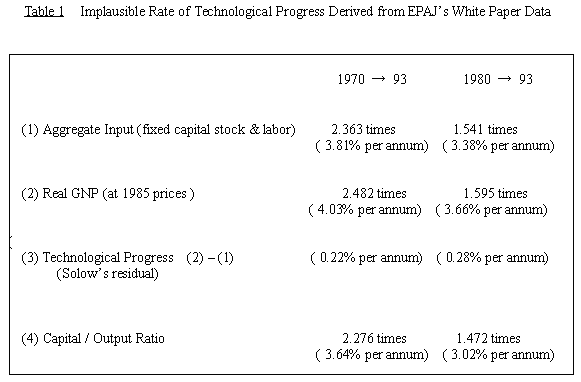
Note: For the computation of aggregate inputs index ( Line 1 ), the aggregation weight is 0.456 for real input index of enterprises’ fixed capital stock ( at 1985 prices ) and 0.544 for labor input index (in terms of total hours worked ). The weights are derived from the official national income (GDP) account for 1985 as the relative proportions of earnings for capital and labor. See EPAJ(1991), pp.80-81. The aggregate computation has been worked out by the use of a weighted geometric mean formula. For the detailed procedures of calculation and data sources for the table, see Haruki Niwa (1995), p.74.
In case we tried to adjust the imputation of the incomes of small not-incorporated private enterprises, the computed weight is 0.42 for capital and 0.58 for labor, as discussed in Section 6 in the text. When we use the adjusted weights, the computed increase in aggregate input is 2.245 times during the 1970-93 period or 3.579% growth per annum. The rate of technological progress (the Sollow’s residual) is 0.43% per annum. The increase in capital/output ratio is 2.31 times during the same period.
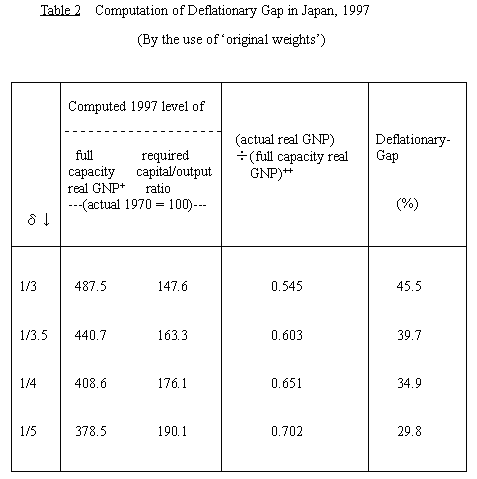
+ With allowance for the minimum deflationary-gap (i.e., 3%).
++ The value of actual real GNP index number for 1997 is 265.8 (1970 = 100).
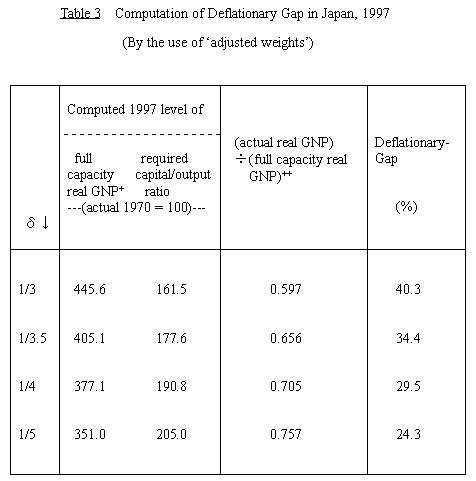
+ and ++ See footnote to Table 2.
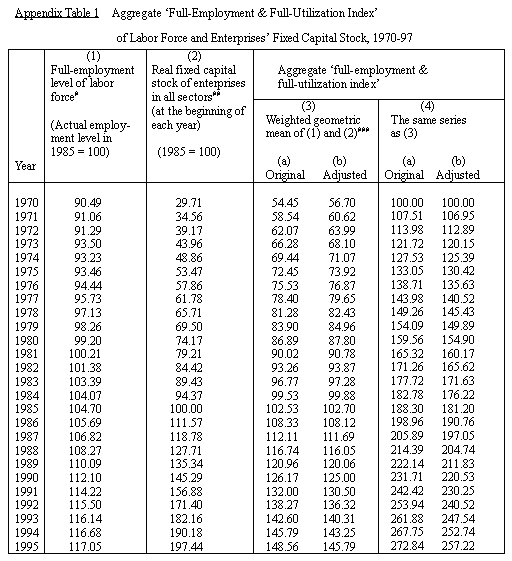
# As cited in the text, in the present study, it is operationally assumed that the rate of employed labor force and average hours worked per head of employed persons in 1970 are virtually equivalent to the conceptual conditions of ‘full employment’. Therefore, it can be assumed that the index number of full-employment level could be regarded as identical with the index number of actual total labor force (1985 = 100) multiplied by 1.047 ( in consequence, the value of the index number for 1985 is 104.7 as cited in the table). Of course, the index of total labor force can be easily derived from the official statistics published by the Statistics Bureau of the Government of Japan. Here, the coefficient, 1.047, shows the difference of ‘rate of employed’ (adjusted for changes in hours worked) in 1970 compared with the corresponding rate in 1985. The derivation of the coefficient is as follows:
Comparative ‘rates of employed’ unadjusted for changes in hours worked in the years 1970 and 1985 are shown below.

The average weekly worked hours per head of employed persons were 48.2 in 1970 and 46.7 in 1985. Consequently, the coefficient should be computed as
( 0.9884 ÷ 0.9738 ) × (48.2 ÷ 46.7) = 1.047 .
The computations above relied on the database, NEEDS , provided by Nihon Keizai Shinbun Sha. See also Bureau of Statistics, Office of the Prime Minister (1974 and 1989), Oct. 1974, pp. 7 ? 10 and Jan. 1989, pp.15 ? 19.
## This is a linked index. The series of enterprises’ fixed capital stock in real terms at 1985 prices (inclusive of construction work in progress) compiled by the Economic Research Institute of EPAJ for 1970 ‐ 93 has been linked with the similar series for 1993 ? 97 in real terns at 1990 prices. See the back number series of EPAJ, Japanese Economic Indicators Quarterlyand Economic Research Institute, EPAJ, National Economic Accounts Quarterly.
### (a) ‘Original weight’ for the labor (column (1) ) is 0.544 and weight for the capital (column (2) ) is 0.456. The weights are derived from the official GDP account for 1985 as the relative proportions of earnings for labor and capital. See EPAJ(1991), pp. 80 ? 81.
(b) ‘Adjusted weight’ for the labor is 0.58 and weight for the capital is 0.42. See Section 6 in the text.
Appendix Table 2 Results of Simulation
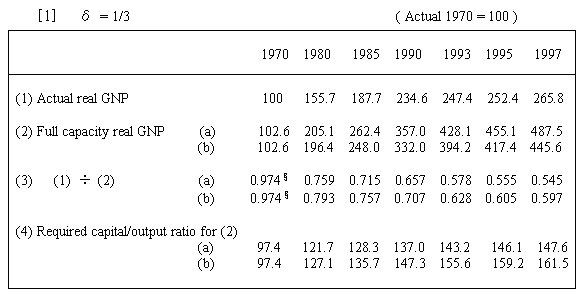
(a) By the use of ‘original weights’. See footnotes to Table 1 and Appendix Table 1.
(b) By the use of ‘adjusted weights’. See Section 6 in the text and also see footnotes to
Table 1 and Appendix Table 1.
§ Exclusive of the minimum deflationary gap (i.e., 3%). As cited in footnote 17 in the
text, 0.97 × (100 ÷ 102.62) = 0.9452 . 100 ÷ 102.62 = 0.97447 ≒ 0.974
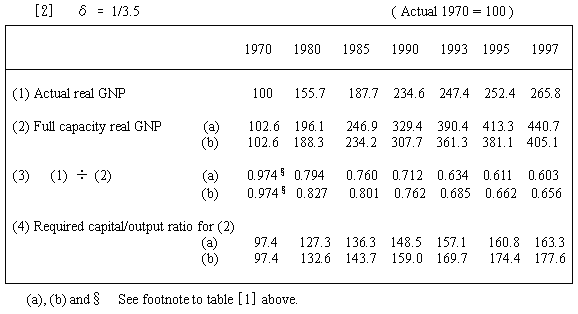
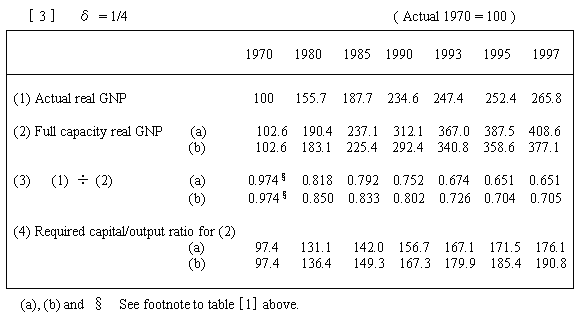
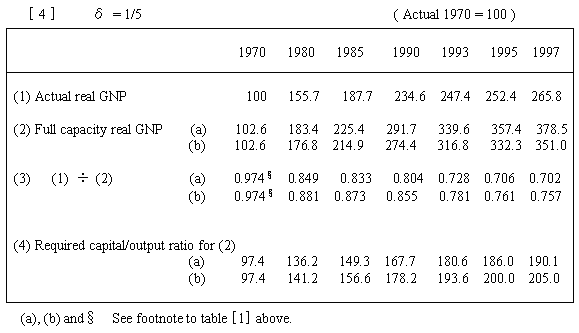
論 文
- 1.政策要求書 : 政策要求書本文、詳論および別表(平成10年9月)
- 2.建白書 : 小泉首相あて建白書「打ち出の小槌」を振る決断を!(平成14年1月)
- 3.建白書への補論 : 政府貨幣と日銀券の本質的な違い(平成14年1月)
- 4.日本経済政策学会 :日本経済政策学会共通論題セッション丹羽報告(平成10年5月)
- 5.Deflationary Gap:東アジア経済学会第6回世界大会丹羽報告(平成10年8月)
- 6.スティグリッツ提案弁護 : スティグリッツ氏の提案は間違ってはいない(平成15年7月)
- 7.日経モデルの問題点 : 日経モデルの問題点(平成15年6月)
- 8.特別論説: ルーカス型総供給方程式の一般化(詳論)(平成13年9月)(pdf:219KB)
- 9.Deflation Gap : -続-デフレ・ギャップ計測−続(平成14年 12月)
Abstract(要約)(pdf:22.2KB) 本文(pdf:585KB)
- 10.政策提言(平成18年秋 ):簡潔明瞭でインパクトのある政策案マニフェスト提案
- 11.危険! 19年度国家財政 :新年度のわが国家財政危うし(『月刊日本』19年2月号)
- 12.重要国策の遂行は絶望 :
マクロ経済学という科学を捨てては重要国策の遂行は不可能(『自由』19年6月号)
- 13.新古典派は市場原理否認:新古典派「反ケインズ主義」は市場原理を尊重していない(『自由』19年7月号)
- 14.「内閣府推計批判」:「内閣府の需給ギャップ推計値は誤りと欺瞞の極致だ!」(「月刊日本」平成19年9月号)
- 15.巨大地震活動期に備えるマクロ政策体系の構築 -「第3の財政財源」確立の方法論を中心に-
- 16.有効需要に生産は即応しうる― 周知の「過剰決定」問題解決として(詳論)
- 17.2013年ケインズ学会大会報告論文
Abstract(要約)(pdf:22.2KB) 本文(pdf:585KB)
